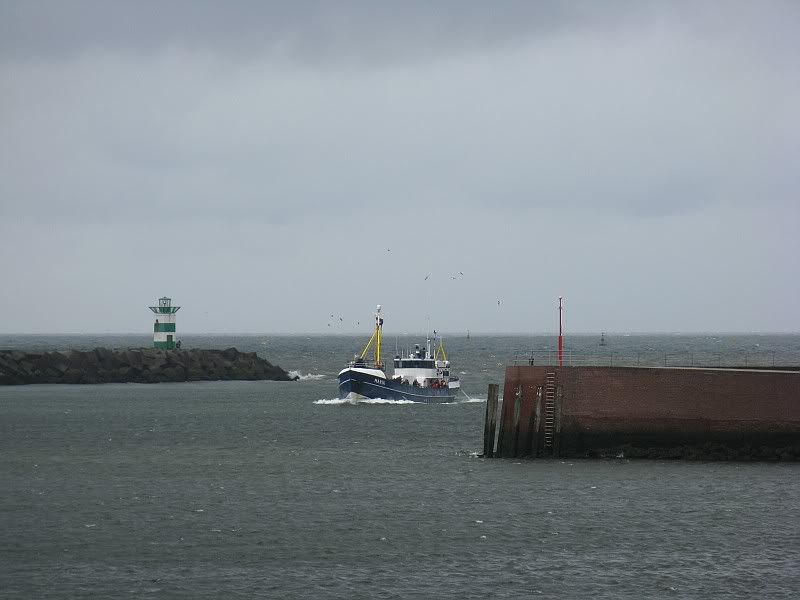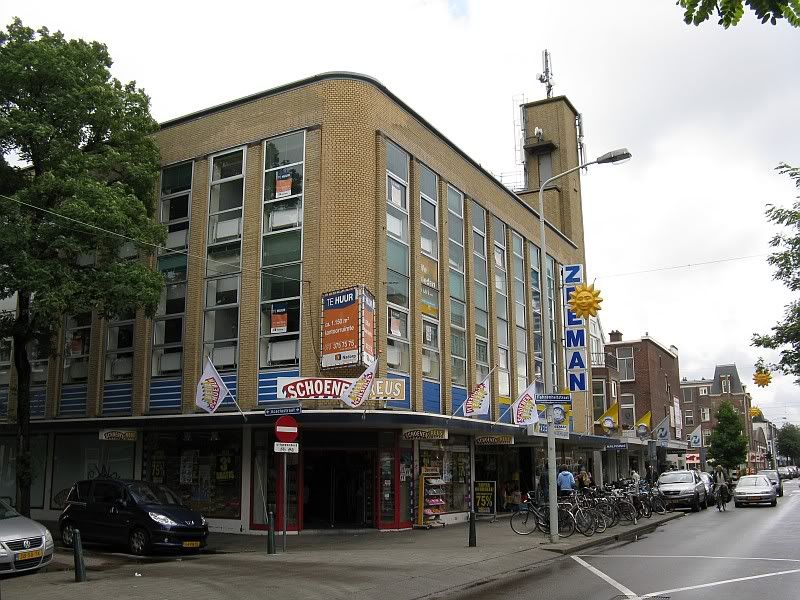Yesterday (2008/07/19) I decided to get on the train with my bicycle to go the The Hague, initially to do some shopping and to shoot some update pictures of the various construction sites in town. But since rain was on the way and I didn't have my umbrella or raincoat with me I decided to make a longer ride through parts of the city that I didn't really know.
You can divide The Hague in two parts, the richer "sands" and the poorer "moors". That's bases on the soil the areas are build, on the coastal side the city was build in the coastal dunes. The inland side of the town were build in the polder on the moors. Sand is a better foundation for the houses, so that's were the big houses were build. While on the muddy soil of the moors, the small houses for the working class were constructed.
I first start of in "Duinoord" and that duin is dune in Dutch.
1. Sweelinckstraat
![Image]()
2.
![Image]()
3. Sweelinckplein
![Image]()
4.
![Image]()
5. towers
![Image]()
6. rain, the trees gave me some shelter.
![Image]()
7.
![Image]()
8. Het Gemeentemuseum (Municipal Museum), designed by H.P. Berlage.
![Image]()
9.
![Image]()
10.
![Image]()
11. We've come into the international zone, with the congress center, with a nice little hotel tower.
![Image]()
12.
![Image]()
13. The "Organisation for the Prohibition of Chemical Weapons"
![Image]()
14. the International Criminal Tribunal for the Former Yugoslavia
![Image]()
15. hotel Bel-Air
![Image]()
16. The next couple of pictures are from the "Statenkwartier", lot's of expats reside here.
![Image]()
17.
![Image]()
18.
![Image]()
19.
![Image]()
20.
![Image]()
21.
![Image]()
22.
![Image]()
23. "Zandheuvel" = sandhill & "Duin en Berg" = dune and mountain.
![Image]()
24. cottage style houses in the middle of the city
![Image]()
Now were moving into Scheveningen, it used to be a small coastal village but it's now part a The Hague. Here the whole sand and moor structure of The Hague doesn't apply for this area. Traditionally the people that work in the fishing industry also live in the village itself
25. typical houses in Scheveningen along the tram tracks.
![Image]()
26. It's not all small, see the Lindoduin flats
![Image]()
27. rain in the harbor
![Image]()
28. but it were only showers
![Image]()
29. cranes
![Image]()
30. the beach, with the skyline of Scheveningen
![Image]()
31. beach football
![Image]()
32. But that should really be played on a sunny day
![Image]()
33. but it was a good day for kite and surfing.
![Image]()
34.
![Image]()
35. Maria comes home
![Image]()
36.
![Image]()
37.
![Image]()
38.
![Image]()
39.
![Image]()
40. There are lots of Seagulls as you would expect in a fishing town.
![Image]()
41. masts
![Image]()
Away from the sea and the harbor heading for the moors.
42.
![Image]()
43. But before that you go through some of the typical pre WW2 neighborhoods
![Image]()
44. the "afvoerkanaal", it's actually called drainage canal the water comes from the polders that are below sea level and it's pumped into the sea.
![Image]()
45.
![Image]()
46.
![Image]()
47.
![Image]()
48.
![Image]()
49.
![Image]()
50.
![Image]()
51. This actually looks like Amsterdam.
![Image]()
52. Now we're moving away from the sands into the moors, into The Hague southwest.
![Image]()
53.
![Image]()
54. don't get lost
![Image]()
Next stop is a neighborhood called "Morgenstond" it's a name for early morning and is one of the early post war neighborhoods. All the different neighborhoods in this area have names that show peaceful it is or names that signify progress. Right now they are not very popular anymore because there are only old small flats. It has also turned in one of the big immigrant neighborhoods, with lots of nationalities living together.
55. Almost all buildings in this area are small 3 or 4 story flats, but are very green.
![Image]()
56.
![Image]()
57.
![Image]()
58.
![Image]()
59. recently some of the flats are demolished to be replaced with typical Dutch single family houses, to create some more diversity.
![Image]()
bonus 1: It's still is a skyscraper forum, "Het Strijkijzer"
![Image]()
bonus 2:
![Image]()
I hope you enjoyed my photos of typical The Hague.
You can divide The Hague in two parts, the richer "sands" and the poorer "moors". That's bases on the soil the areas are build, on the coastal side the city was build in the coastal dunes. The inland side of the town were build in the polder on the moors. Sand is a better foundation for the houses, so that's were the big houses were build. While on the muddy soil of the moors, the small houses for the working class were constructed.
I first start of in "Duinoord" and that duin is dune in Dutch.
1. Sweelinckstraat

2.

3. Sweelinckplein

4.

5. towers

6. rain, the trees gave me some shelter.

7.

8. Het Gemeentemuseum (Municipal Museum), designed by H.P. Berlage.

9.

10.

11. We've come into the international zone, with the congress center, with a nice little hotel tower.

12.

13. The "Organisation for the Prohibition of Chemical Weapons"

14. the International Criminal Tribunal for the Former Yugoslavia

15. hotel Bel-Air

16. The next couple of pictures are from the "Statenkwartier", lot's of expats reside here.

17.

18.

19.

20.

21.

22.

23. "Zandheuvel" = sandhill & "Duin en Berg" = dune and mountain.

24. cottage style houses in the middle of the city

Now were moving into Scheveningen, it used to be a small coastal village but it's now part a The Hague. Here the whole sand and moor structure of The Hague doesn't apply for this area. Traditionally the people that work in the fishing industry also live in the village itself
25. typical houses in Scheveningen along the tram tracks.

26. It's not all small, see the Lindoduin flats

27. rain in the harbor

28. but it were only showers

29. cranes

30. the beach, with the skyline of Scheveningen

31. beach football

32. But that should really be played on a sunny day

33. but it was a good day for kite and surfing.

34.

35. Maria comes home

36.

37.

38.

39.

40. There are lots of Seagulls as you would expect in a fishing town.

41. masts

Away from the sea and the harbor heading for the moors.
42.

43. But before that you go through some of the typical pre WW2 neighborhoods

44. the "afvoerkanaal", it's actually called drainage canal the water comes from the polders that are below sea level and it's pumped into the sea.

45.

46.

47.

48.

49.

50.

51. This actually looks like Amsterdam.

52. Now we're moving away from the sands into the moors, into The Hague southwest.

53.

54. don't get lost

Next stop is a neighborhood called "Morgenstond" it's a name for early morning and is one of the early post war neighborhoods. All the different neighborhoods in this area have names that show peaceful it is or names that signify progress. Right now they are not very popular anymore because there are only old small flats. It has also turned in one of the big immigrant neighborhoods, with lots of nationalities living together.
55. Almost all buildings in this area are small 3 or 4 story flats, but are very green.

56.

57.

58.

59. recently some of the flats are demolished to be replaced with typical Dutch single family houses, to create some more diversity.

bonus 1: It's still is a skyscraper forum, "Het Strijkijzer"

bonus 2:

I hope you enjoyed my photos of typical The Hague.




